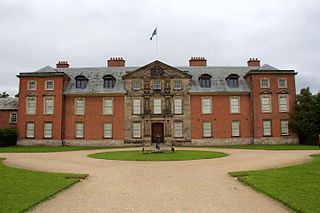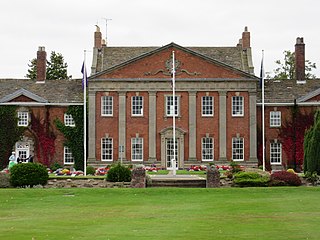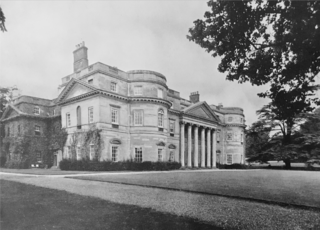
Firbeck is a village and civil parish in the Metropolitan Borough of Rotherham in South Yorkshire, England, on the border with Nottinghamshire. It lies between Maltby and Oldcotes, off the A634 and B6463 roads. Firbeck had a population of 317 in 2001, which had fallen to 299 at the 2011 Census.

Saltram House is a grade I listed George II era mansion house located in the parish of Plympton, near Plymouth in Devon, England. It was deemed by the architectural critic Pevsner to be "the most impressive country house in Devon". The house was designed by the architect Robert Adam, who altered and greatly expanded the original Tudor house on two occasions. The drawing room is considered one of Adam's finest interiors. Saltram is one of Britain's best preserved examples of an early Georgian house and retains much of its original decor, plasterwork and furnishings. It contains the Parker family's large collection of paintings, including several by Sir Joshua Reynolds (1723-1792), born and educated at Plympton and a friend of the Parker family.

Papplewick is a village and civil parish in Nottinghamshire, England, 7.5 miles (12 km) north of Nottingham and 6 miles (10 km) south of Mansfield. It had a population of 756 at the 2011 census. In the Middle Ages, the village marked the southern gateway to Sherwood Forest.

Hodsock Priory is an English country house in Hodsock, Nottinghamshire, 4 miles (6.4 km) north of Worksop, England, and 1 mile (1.6 km) south of Blyth. Despite its name, it is not and never has been a priory. Hodsock is renowned for its snowdrops in early spring. It is also a venue for special events and weddings.

Serlby Hall is a grade I listed 18th century mansion and estate in Nottinghamshire, England, located 7 miles north-east of Worksop.

General Henry Robinson-Montague, 6th Baron Rokeby, was a senior British Army officer of the 19th century.

Dunham Massey Hall, usually known simply as Dunham Massey, is an English country house in the parish of Dunham Massey in the district of Trafford, near Altrincham, Greater Manchester. During World War I it was temporarily used as the Stamford Military Hospital.

West Dean House is a large flint-faced manor house situated in West Dean, West Sussex, near the historic City of Chichester. This country estate has approximately 6,350 acres (25.7 km2) of land and dates back to 1086, with various royal connections throughout the years. In 1971 the Estate became the home of West Dean College, a centre of study of conservation, arts, crafts, writing, gardening, and music.

The Manor of Clifton was a historic manor situated near the City of Nottingham, England. The manor house, known as Clifton Hall is situated on the right bank of the River Trent in the village of Clifton, Nottinghamshire,. about 3+1⁄2 miles south-west of the historic centre of the City of Nottingham, now partly the campus of Nottingham Trent University and partly a large council estate of modern housing.

Milton Hall near Peterborough, is the largest private house in Cambridgeshire, England. As part of the Soke of Peterborough, it was formerly part of Northamptonshire. It dates from 1594, being the historical home of the Fitzwilliam family, and is situated in an extensive park in which some original oak trees from an earlier Tudor deer park survive. The house is a Grade I listed building; the garden is Grade II*.

Frederick Montagu was a British Whig MP.

Mottram Hall is a former country house to the northeast of the village of Mottram St. Andrew, Cheshire, England. It is recorded in the National Heritage List for England as a designated Grade II* listed building. It is not to be confused with Mottram Old Hall.
Slebech was a community in Pembrokeshire, Wales, which is now part of the combined community of Uzmaston and Boulston and Slebech, a sparsely populated community on the northern shore of the Eastern River Cleddau. The community shares boundaries with the communities of Wiston and Llawhaden and mainly consists of farmland and woodland. Much of the community is within the Pembrokeshire Coast National Park and Picton Castle's stable block loft is an important breeding roost for the rare Greater Horseshoe Bat.

Wallsworth Hall is a stately home in the parish of Sandhurst, Gloucester, England. It is a Grade II* listed building.

John Fountayne (1714–1802) was a Church of England clergyman and the longest serving Dean of York.

Rushton Hall in Rushton, Northamptonshire, England, was the ancestral home of the Tresham family from 1438, when William Tresham, a veteran of the Battle of Agincourt and Chancellor of the Duchy of Lancaster bought the estate. In the 20th century the house became a private school and it has now been converted to a luxury hotel. The estate is about 227 acres (92 ha) of which 30 acres (12 ha) are formal gardens. The River Ise flows from west to east south of the Hall.

Thurnham Hall is a Grade I listed 17th-century country house in the village of Thurnham, Lancashire, England some 10 km south of Lancaster.

Frances Margaret Wodehouse, Countess of Kimberley was an English socialite and member of the Bright Young Things. She married three times, always with members of the British aristocracy. She scandalized society when she went to live with her future second husband without waiting for her divorce to be effective.
Charles Montagu, of Papplewick, Nottinghamshire. was a British landowner and politician who sat in the House of Commons between 1722 and 1759.

Horton Hall, known locally as Horton House, was a stone-built Georgian stately home, now demolished, located on a 3,764 acre estate stretching across nine parishes on the Northamptonshire and Buckinghamshire borders.



















